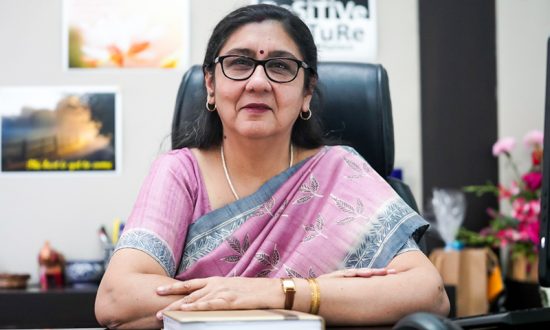With A Masters’ Degree in English Literature and a career spanning 38 years, Radhika Sinha is a teacher at heart and continues to be an avid ‘learner.’ She has been with the school since inception and with the Aditya Birla Group for 16 years. She has been accredited by Cambridge International as a Master Trainer to conduct in-service training programmes for teachers. Radhika Sinha is on the Board of The Association of International Schools of India (TAISI). Having acquired the wealth of experience, it is her wish to give back to society by sharing and mentoring, guiding and leading by example.
The pandemic caused an upheaval in the education system with an unexpected, sudden shift to online platforms which led to many changes in perspectives around learning. During the initial days, many schools tried to figure out the most reliable techniques to implement classes virtually. Globally, challenges imposed by the pandemic were looked upon as opportunities to upscale technology and to apply it in virtual classrooms. Integrating and blending technology with the teaching methods and practicing innovative techniques has become the need of the hour. Automating systems such as student attendance, project assessment, the evaluation process, etc. have also become easy with technology.
Swift shift to online learning
The virtual schooling scenario caused parents to offer mobile phones and gadgets to children, as it became impracticable to study without an electronic device and internet connectivity. The internet became a central part of conducting virtual education and even if the circumstances do get better over time, this arrangement of teaching could stay for long. The whole system of teaching had to undergo a paradigm shift. In this context, digital platforms and learning tools played a major role in facilitating educators across sections to manage both synchronous and asynchronous classes in an attempt to share meaningful content, as well as keep students engaged. Accessing online learning has also matured as a seamless process owing to the convenience of having affordable internet facilities.
Role of educators in facilitating e-classrooms
Teachers have been welcoming fresh opportunities to learn, by discovering innovative ways to focus on the requirements of students. They have become well acquainted with digital devices and are using the right technologies to guarantee efficient and quality learning in virtual classrooms. From attending face-to-face classes, teachers have now got accustomed to management systems. Textbooks have been substituted with web resources and teachers have integrated LMS for everyday teaching. They have implemented digital formative evaluation tools, virtual instruction software, online and hybrid teaching to facilitate the learning process. Constant upskilling encourages teachers to stay relevant – particularly in the online classroom scenario.
Imparting technology tools
Technologies like AI have streamlined tasks of educators by automating activities like grading and passing feedback to students. Teachers have begun to recognize the potential of using artificial intelligence and how its application can transform the entire education system. Another technology adopted by educational institutes is cloud computing which has helped the route towards advanced-tech learning for everyone. The cloud servers of educational platforms have enabled students to access advanced information seamlessly. The new normal of the digital world has made utilizing technology a fundamental part of our lives.
To make virtual learning more fun, engaging, and effective for teachers as well as students, there are multiple technology tools available in the market such as Quizizz, Google Classroom, Edmodo, Padlet, Microsoft Flipgrid, Flippity, Coggle, Peardeck, VoiceThread and Kahoot. Also, video conferencing platforms have helped engage students, staff, and teachers for learning and collaborating, providing the opportunity to connect synchronously. These tools combined with affordable data have provided remote learning opportunities accessible even in rural regions. Designing digital sources, presentations, and assignments collectively for online classes with other administrators and students is helping classroom exercises mirror the physical classroom experience.
The pandemic has made adapting to the use of technology a fundamental part of our lives. Even for teachers, technology has evolved as the most important professional tool to impart education online. Empowering students to enhance their technical abilities will help them prepare for a better future in the real world. New tools and advancements in technology will continue to emerge, and the education sector needs to adapt to them!




